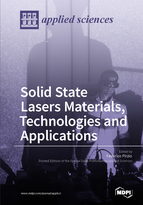Solid State Lasers Materials, Technologies and Applications
A special issue of Applied Sciences (ISSN 2076-3417). This special issue belongs to the section "Optics and Lasers".
Deadline for manuscript submissions: closed (31 October 2017) | Viewed by 98645
Special Issue Editor
Interests: diode pumped solid state lasers and amplifiers, design and modeling; diode pumped femtosecond lasers; laser materials; nonlinear optics; parametric oscillators and amplifiers; microchip lasers; ultrafast fiber lasers and amplifiers
Special Issue Information
Dear Colleagues,
Despite the fact that more than half a century has already passed since the first demonstration of laser action in ruby crystal, solid-state lasers are still a hot research topic. Their unique versatility has made them irreplaceable tools in an astonishing variety of application: From the detection apparatus for gravitational waves, to the trapping and cooling of atoms, from minimally invasive surgery, to the remote sensing of atmospheric contaminant, from the mass production of smartphone displays, to the cutting and processing of solar cells. The list of actual or potential applications is continuously being updated at a pace that is set by the rate of advancing research.
This virtuous cycle is only made possible by the favorable interplay between continuous research progress, enabling new exciting applications, and the emergence of new needs from industrial markets and fundamental research fields, fostering the study of new materials, the development of new technologies, and the fast maturation of the existent ones.
It is my pleasure to invite you to contribute to this Special Issue of Applied Sciences, which is aimed at presenting recent advances in the field of Solid State Lasers. We will focus on new materials for generation/amplification of ultrashort laser pulses, for nonlinear frequency conversion, and on the recent advances in solid-state laser technologies and applications.
We invite the submission of original research articles. Review articles on a sub-topic of the Special Issue are also welcome, and should give a well-balanced overview of the field and include main results from other groups.
Dr. Federico Pirzio
Guest Editor
Manuscript Submission Information
Manuscripts should be submitted online at www.mdpi.com by registering and logging in to this website. Once you are registered, click here to go to the submission form. Manuscripts can be submitted until the deadline. All submissions that pass pre-check are peer-reviewed. Accepted papers will be published continuously in the journal (as soon as accepted) and will be listed together on the special issue website. Research articles, review articles as well as short communications are invited. For planned papers, a title and short abstract (about 100 words) can be sent to the Editorial Office for announcement on this website.
Submitted manuscripts should not have been published previously, nor be under consideration for publication elsewhere (except conference proceedings papers). All manuscripts are thoroughly refereed through a single-blind peer-review process. A guide for authors and other relevant information for submission of manuscripts is available on the Instructions for Authors page. Applied Sciences is an international peer-reviewed open access semimonthly journal published by MDPI.
Please visit the Instructions for Authors page before submitting a manuscript. The Article Processing Charge (APC) for publication in this open access journal is 2400 CHF (Swiss Francs). Submitted papers should be well formatted and use good English. Authors may use MDPI's English editing service prior to publication or during author revisions.
Keywords
- Diode pumped ultrafast solid state lasers and amplifiers
- Tunable and new wavelength lasers
- Optically pumped semiconductor lasers
- Microchip and compact lasers
- Ultrafast fiber lasers
- Solid state laser sources based on nonlinear frequency conversion schemes
- New materials for diode pumped ultrashort pulse generation/amplification
- Solid state laser systems for special applications






